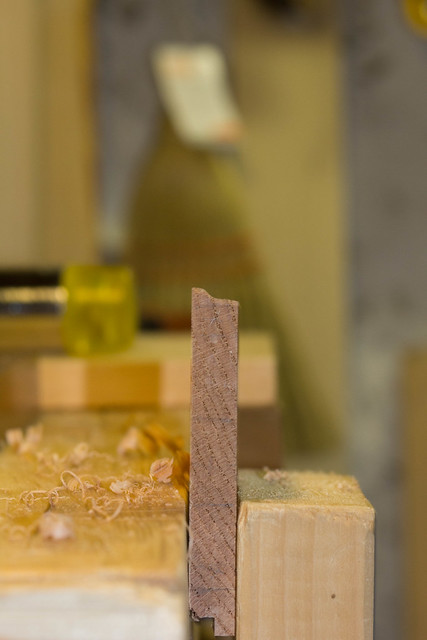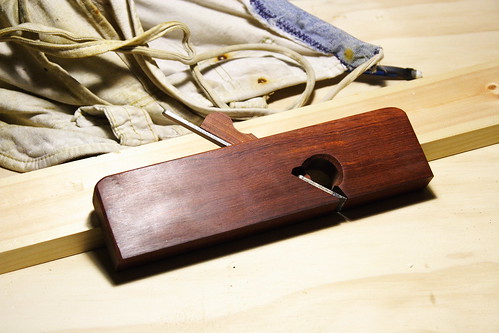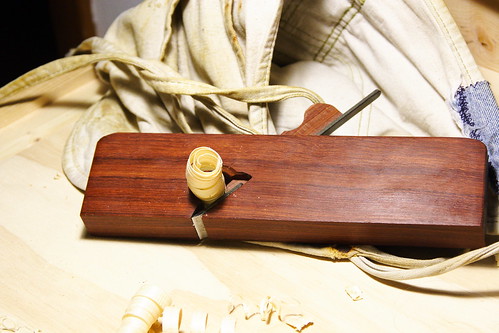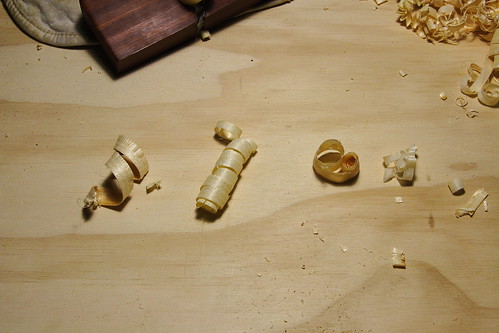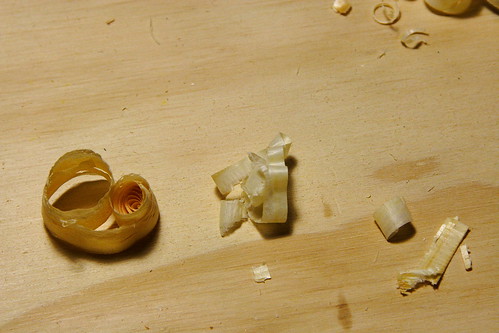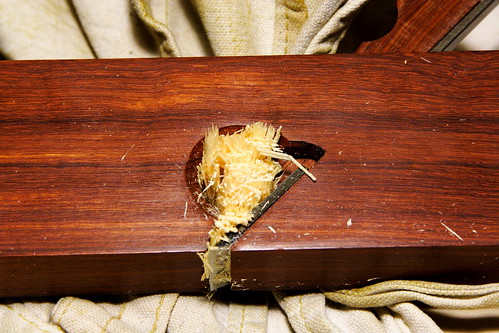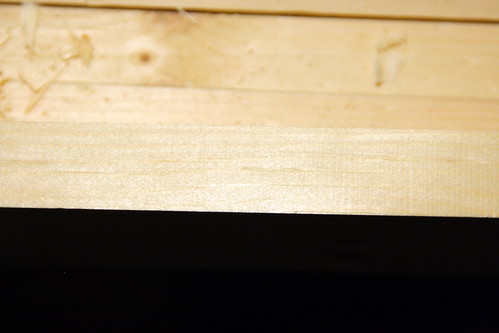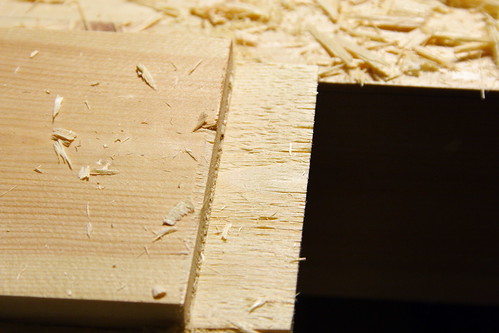Note: Originally posted 11-16-2011 at
http://woodworkingtalk.com. This is now considered to be the first of the Cheap Tool Reviews. I question the decision now, but it's still pretty cheap for a band saw, so I'll live with it.
I just bought one of these after reading a lot of reviews. One problem I had in making a decision was that the reviews I was finding were almost all at least a few years old, and there have been some changes to the design of the saw since then. So, in hopes of helping out people who are looking now, I thought I'd post my thoughts.
To start off, I have almost no experience with bandsaws; I've used one before, but mostly for metal cutting, not wood. Bearing that in mind, here we go..
0) What I didn't use.
I knew from the reviews that a link belt was highly recommended. Since I was at HF anyway, I bought theirs. Other than that, everything is stock, although I'll be replacing the blade as soon as possible.
1) Moving and packing.
It's a heavy box, but not completely unmovable. I got it out of my car on my own by sliding it onto a furniture dolly, then rolled it into the garage. Getting parts out of the box was an interesting experience. The base and table were on top, right up against the cardboard, set into a molded styrofoam tray. Removing the tray revealed the rest of the saw, assembled and with a blade in it, and the motor. No evidence anywhere of fasteners or a manual. Why? Well, because those were UNDER the saw. In a little nook that was completely hidden until you'd lifted the saw. Anyway. On the plus side, everything was in the box (with one odd sort-of-exception, which I'll mention later), which rather surprised me.
2) Assembly.
A) The base. This went really smoothly. Contrary to my expectations, the instructions were quite clear, all the parts were there, and all the necessary screw holes were cleanly cut and lined up where they were supposed to. The base looked like it was going to have a lot of gaps, but tightening down the fasteners with a wrench closed them all up. As a side note: except for the belt guard housing, every nut and bolt used in assembly is 13mm. I recommend making sure you've got a 13mm box wrench AND a 13mm driver on a ratchet before you start working. You'll want them both.
B) The saw. There wasn't much to assemble here. It was all pre-built, with a blade installed, and all the fasteners tightened down. That's a bonus, because this is where the manual was least clear. The table and its mount DID need to be installed, which was quick and easy. It was also where the "sort-of-exception" I mentioned above came in. The instructions claim you're supposed to use two M8x30 bolts to attach the table bracket. By that time in the assembly, I only had one of them left. However, I also had an M8x35 (more or less) bolt that wasn't called for in the instructions anywhere. As it turned out, it was exactly the right length for the right-most of the two holes I was supposed to be bolting the bracket into, so I decided to just use it and not worry.
C) The motor. Installing the motor was a pain, but not terribly difficult. It absolutely required two people; the motor has to be held upside down under an angled bracket, and then bolts have to be run through from underneath and nuts put on them from the top. I can't help feeling like there must have been a better way to design that.
I'm also going to mention the belt-guard box here: that also sucked, and was probably the hardest part of the entire assembly. It requires putting four fairly small pan-head bolts through four similarly small holes, all on the inside of the assembly, and the drive pulleys pretty much meant I couldn't get my hands anywhere within four inches of the rear holes. A long pair of needlenose pliers solved the problem, but it was a nuisance after everything else being so easy.
Assembly probably took around an hour and a half, including checking to make sure the wheels and pulleys were lined up and tensioned correctly.
3) Fit, finish, and accessories.
I'm favorably impressed by the saw as a whole. While the sheet metal edges on the base aren't rounded over, they're also not as sharp as some bases I've worked with.
Once all the nuts were tightened, everything seemed quite solid. The blade tension was really low (essentially no tension) out of the box, but the tensioner works well, and the knob on the new version sticks up above the top of the saw, so it's easy to use. While the table bracket looks and feels like plastic, it seems to actually be cast aluminum with a plastic coating -- tap it and it rings like cast aluminum, and it's too heavy to be plastic.
One frequent complaint in the old saw was that the side panels that cover the wheels aren't hinged. Well, they are now. That's mentioned in comments on a few older reviews, but I thought I'd make it part of the body of this one. The lower panel on both my saw and the display model has to be really slammed shut to latch; I'll likely replace the catch with a magnet eventually.
Something I haven't seen mentioned anywhere is that the new model has a brush set to sweep off the lower wheel, out of the box. I'd planned to buy and install one, but now I don't have to.
There are two places where there are angle gauges: the table tilt measure, and the miter gauge. Neither is perfect, but both are adjustable. The table's gauge was off by around a degree: once I'd squared the table to the blade, I reset it to zero, then used a Wixey digital angle gauge to check the rest of the readings. They're certainly very close - within two tenths of a degree, as far as I could tell -- and should do for most purposes. For anything really precise, I've got the digital gauge, which is easier to read anyway.
The miter gauge... what can I say about it? It's cheap plastic with numbers molded into it, and it's screwed to a cheap piece of aluminum c-channel that more or less fits the miter slot. The tick marks for the angle indicators are a good eighth of an inch across. We're not talking "high precision" here. If I need to set an accurate angle, I'm going to use a protractor, rather than trusting the miter gauge. It does have an adjustable needle, so I can set it to "90 (or 30, or 45) degrees plus or minus a little", but that's about as good as it gets. It also doesn't really slide through the slot cleanly, because it gets hung up on the mouth for changing the blade. I'm planning to round off the front corners of the gauge, to see if that helps. It does more or less lock in place, but I suspect it will cease to do so pretty quickly. I don't expect to need the gauge all that often, though, so maybe it won't really matter.
A number of people complained about the drive belt being lumpy and uneven. While I didn't use the one I got -- I'd bought a link belt, so why bother with it? -- it seems to be OK. I'd still say go with the link belt: by all accounts they decrease vibration, and the added expense brought the price even with the Ridgid and Porter-Cable 14" saws, rather than above them. (Actually, if your local Lowes/HD won't accept HF coupons, it's still a lot cheaper than either...)
The blade that came with it is, as you'd expect, not very good. I made a couple of test cuts in some scrap 3/4" ply, and it works, but not well. It did cut fairly straight, and with essentially no drift across a six inch cut, though, so it's probably passable as an emergency backup. The manual claims it's 6TPI and 3/8" width. I haven't counted, but I would have guessed 8 or 10 TPI from a quick look. I did notice a couple of damaged teeth before I used it, and I suspect there are more, so it's not going to get used much, if at all.
4) Final thoughts.
I had just about been convinced to buy a Grizzly before I bought this. It occurred to me, though, that I know for a fact I was going to want to cut metal with it, and the Grizzly just doesn't step down to speed that I'm comfortable with for that. Between that and the option to save $200, the HF model seemed like the right choice. If money hadn't been a concern, I probably still would have gone with the Grizzly, and bought a cheap low-speed benchtop or something for cutting metal. As it was, versatility won out over quality.
I do plan to buy the riser kit for the saw: it's currently available from HF parts for $85 + shipping, although it can't be bought in the stores. I'll be building a fence -- there was a fairly nice set of plans in the most recent ShopNotes for a rip and resaw fence that can accommodate for drift -- rather than buying one, and I have pretty much all the parts for that. So with the addition of the riser and a couple of good blades, I'll have a tool that should do everything I need (and most of what I want) for a pretty good price.
Overall, I'm pleased with my decision, and suspect I made a right choice, if not THE right choice.
---------------------------------------------------------------------------------------------------------------------------------
Would I recommend this saw? Yes. But, as with most HF products, be prepared to bring it back if you find out it's a lemon. They're not likely going to all have all the parts, so assume that yours will have some problems. If you want a reliable out-of-the-box machine in this price range, I'd recommend the Porter-Cable. That's the only one I haven't seen reports of people needing to make major modifications to. It's also one of the least versatile, so you take your chances... for me, the HF was the right choice.
If money isn't much of an issue, I'd probably recommend going higher-scale. The miter gauge with this one is really junk, and it doesn't have a fence. Going with, say, the Grizzly I thought about would have resolved both of those problems, out of the box. It is a lot more expensive though, so again, it's about making tradeoffs.







